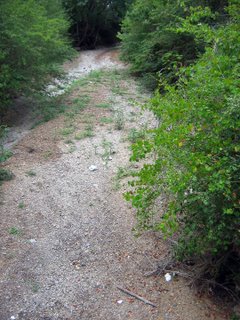We went out yesterday and visited 4 flame chub sites, one in Florence and the other three to the northwest in the Cypress Creek system. The weather was clear and hot again; north 'bama hasn't even gotten an inch of rain in the last month so the creeks were all low, making our job easier.

Above is a close-up shot of our first site, King (Buffler) Spring on the northern edge of the city of Florence. The spring pool is ankle-deep cold water, with miniature volcanoes of water bubbling up through the sand at odd intervals. The property is owned by a consortium of groups including the Audubon Society, protecting it from development; on two sides there is industrial development, up to within about 200 meters of the spring pool. This site has produced hundreds of flame chubs in some collections from the 1970s. We found a flame chub fairly quickly, and also
lots of Tuscumbia darters, another imperilled spring fish.
Gambusia are also in the spring.
Our next stop was Greenbrier Branch, a tributary to Cypress Creek just to the northeast of the crossroads of Cloverdale. The bridge that gave us access was fairly high, and below it was a pool deep enough for two of my students to dive into. The pool was full of big bass and sunfish and also some log perch. We crossed upstream under the bridge and found the slow run pictured below, which turned out to have large schools of minnows including lots of flame chubs. We caught and kept two adults and a young-of-the-year. The splash in the photo is a rock-skipping competition as we rolled up the seine.

Next we went to a site on Cypress Creek itself. Cypress Creek runs south from Tennessee draining the center of Lauderdale County, and is famous for high fish biodiversity. We went to a site southwest of Cloverdale on County Road 8 which had produced 4 flame chubs in 1974. We were able to drive off the road onto a broad beach of cobble next to the bridge, and only slightly disturbed the family who were sunning and swimming on the upstream side of the bridge. We popped out and started seining just below the bridge. In short order we'd found
lots of scarlet shiners, northern studfish, and two species new to us on this project: warpaint shiners (
Luxilus coccogenis) and highland shiners (
Notropis micropteryx). The warpaints were in full breeding warpaint, with red marks all around the head and colored fins like below:

The male scarlet shiners were in full dudgeon, too:

Here's a photo of one of the highland shiners:

We also caught a redline darter,
Etheostoma rufilineatum. The hourglass marking at the base of the caudal fin is unmistakable:

But with all of this, we found no flame chubs. The bridge had been recently rebuilt, and there was a lot of evidence that a large stretch of creek was dug up and generally altered in the process. Cypress Creek is fairly big and fastflowing at this point, which doesn't make this area prime flame chub habitat in the first place although it's preferred by the four species pictured above. A lot of tree stumps can be found along the current creek bed. Here's a shot of the bridge and creek, looking upstream from below the bridge:

As an example of how this creek has been recently altered, here's a close-up of creek bank just across the creek from where the above photo was taken. Notice the water flow and apparent volume; it felt good on a hot summer day:

So, my working hypothesis is that flame chubs don't like the current physical environment around this bridge and aren't found there. They're likely found not too far upstream, which is unaltered, but our sampling protocol is to sample about a 200 meter stretch of creek, so we didn't go much above the bridge.
Finally, our fourth site, nearby Lindsay Creek which is also a Cypress Creek tributary, looked good except for one thing: it was full of cows that had access to the creek both above and below the County Road 15 bridge. Two of my students were distinctly nudgy at the thought of seining in a creek frequented by cows so we didn't sample there. And access would have been difficult, since the only way down to the creek not blocked by barbed wire required dropping down a concrete abutment almost two meters. This site had produced flame chubs twice in 1968 and once in 1974. I suspect that it didn't have cows in it then. So this site won't count yea or nay for flame chubs in my survey, I'll just footnote it with a "wading cows" warning.
 North Fork of Cypress Creek wasn't a whole lot better, as you can see in the photo below. It was a series of elongated pools, 4-5 meters long and maybe 1 meter wide, with 20-50 meters between pools.
North Fork of Cypress Creek wasn't a whole lot better, as you can see in the photo below. It was a series of elongated pools, 4-5 meters long and maybe 1 meter wide, with 20-50 meters between pools.













